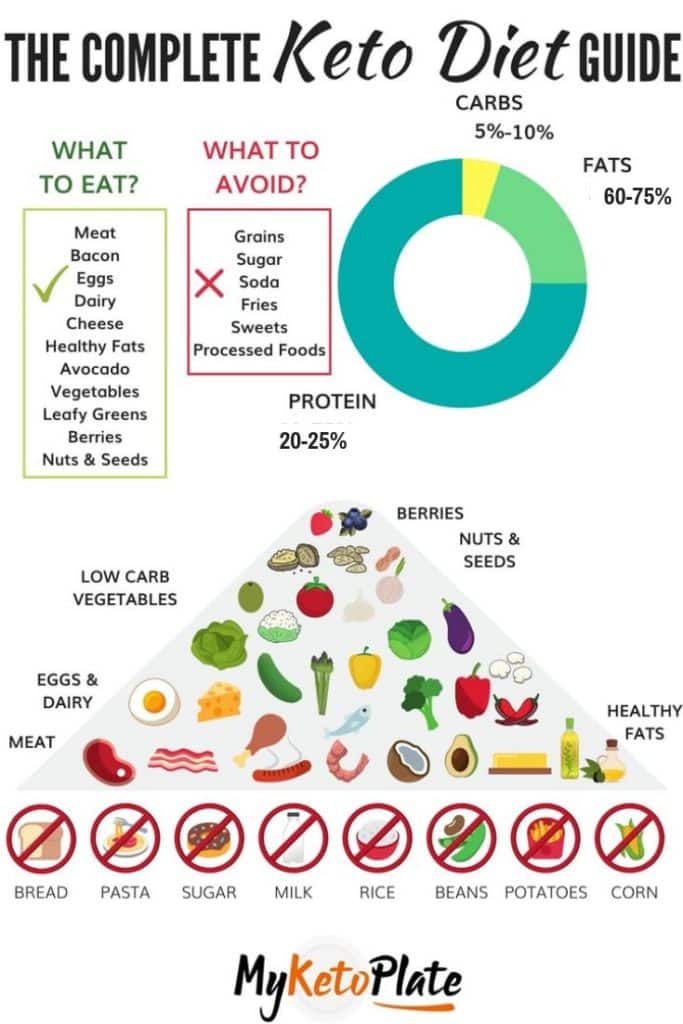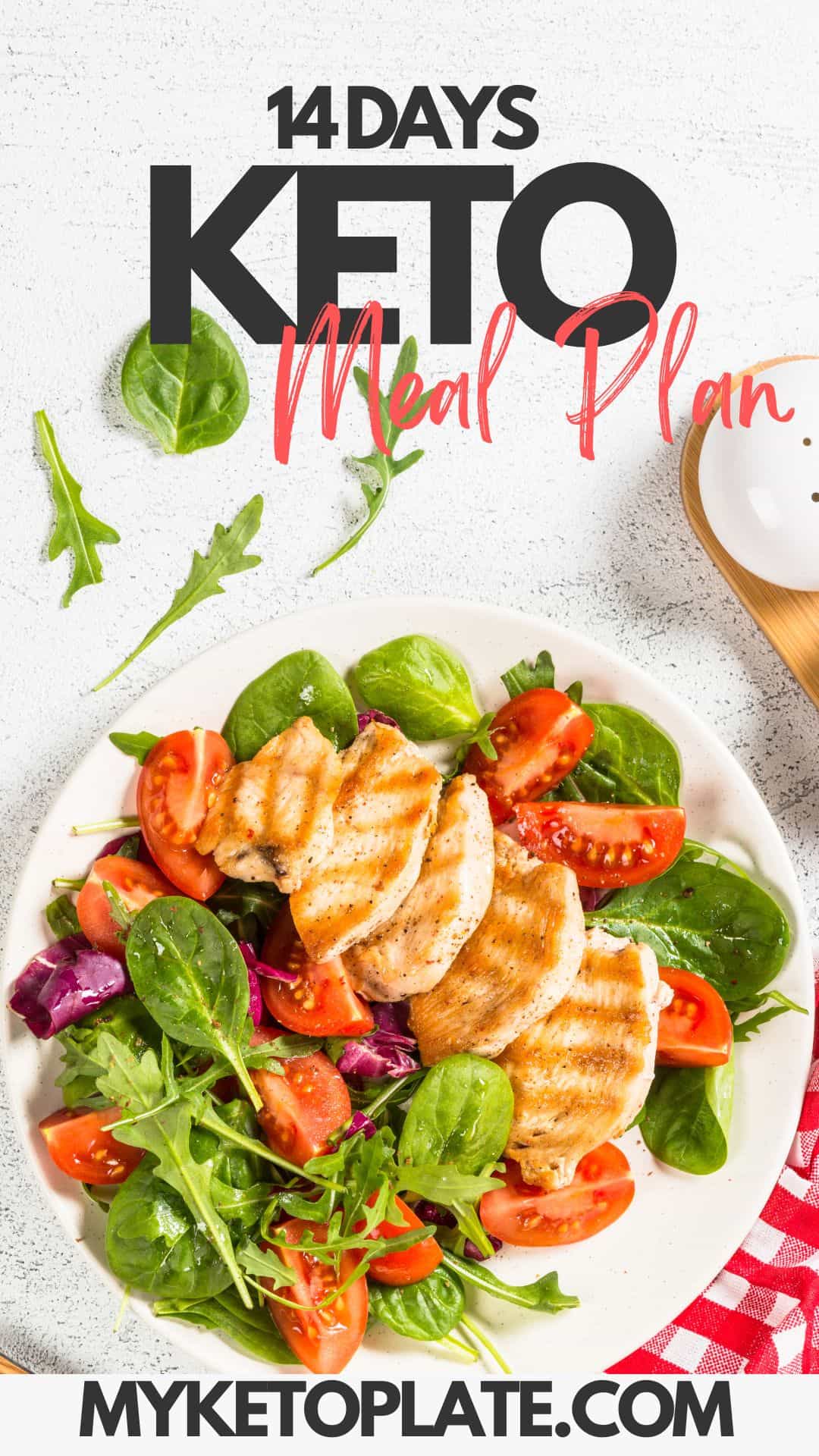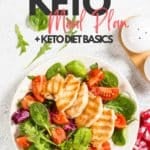Ketogenic diet, also known as the keto diet, is a low-carb, high-fat diet that can help you burn fat more efficiently and improve your overall health. The basic principle of the keto diet is to consume foods that are low in carbs, moderate in protein, and high in healthy fats.
You decided to learn more about the keto diet and what happens to the body in the state of ketosis.

This type of diet is a low-carb high-fat way of eating that comes with many health benefits, all backed by many scientific studies.
Eating a ketogenic diet may help you lose weight, and improve general health and it’s shown to have a positive effect against diabetes, epilepsy and even cancer.
I created this short and comprehensive guide to help you understand the basics of the keto diet.
What is a Ketogenic Diet?
A ketogenic diet is also known as keto is a high-fat, low carb and moderate in protein diet. Eating more fat and small amounts of carbs help your body to enter ketosis.
Ketosis is a state where your body switches the primary fuel to ketones (instead of glucose). Your liver produces ketones, from fat that are used as fuel both when the food intake is low or when we eat fewer carbs. This new fuel is preferred even by the brain over, and it can run solely on fat.
Our bodies can adapt very well to different situations. You can also produce ketones when you are fasting (not eating), but I’m not sure if we can live without food forever.
In a typical keto diet, the daily carbohydrate intake is limited to 20-50 grams per day, while the fat intake is increased to around 70-80% of total daily calories. Protein intake is moderate, around 10-20% of total daily calories.
Ketosis turns your body into a fat-burning machine with many health benefits, including weight loss, better focus and
Health Benefits of Keto
- Weight Loss
Many people start lowering carbs with the goal of weight loss and most of them encounter great success. Burning fat for fuel is excellent because you eat tasty foods you’re not hungry all the time. Studies show that low carb high-fat diets are better for fat loss than any other way of eating.
- Suppresses appetite
Studies show that eating foods high in fat and restricting carbs, while eating to satiety will help you feel less hungry over time. Ketosis prevents the hunger hormone (Gherlin) from rising. You’ll have no desire to eat, it also helps with stress eating and the hunger will disappear.
- Constant energy and mental clarity
Many people notice an increase in energy levels. Ketosis is a more reliable energy source that keeps your body steadily fueled, and you avoid big blood sugar drops. Brain fog will be gone for good.
Studies also show that a keto diet improves memory and productivity (https://www.ncbi.nlm.nih.gov/pubmed/15123336)
- Improved cholesterol and blood sugar levels
One 2004 study shows the effect that keto has on obese individuals:
- Improved cholesterol levels: From week one to week 24, the level of total cholesterol decreased
- The good cholesterol HDL cholesterol levels significantly increased
- LDL cholesterol (the bad one) levels decreased considerably
- Decreased triglycerides: The level of triglycerides (fat) decreased substantially following 24 weeks of treatment
- Reduced blood glucose: The level of blood glucose was significantly reduced.
It’s an excellent method to reverse type 2 diabetes, to prevent it or to keep it under control.
Four Different Types of Ketogenic Diet
There are several versions of the ketogenic diet, including:
- Standard ketogenic diet (SKD): This is the most common version and the one I recommend if you are just starting. The rules are to consume 20-50 grams of net carbs per day. 75% of your diet should come from fats and 20-25% from protein.
- Targeted ketogenic diet (TKD): This type allows you to eat 20-50 grams of net carbs before working out. Great for very active individuals to maintain exercise performance.
- Cyclical ketogenic diet (CKD): means you alternate the carb intake during the week. You keep the carbs at a minimum for 5-6 days then, you have a few high carbs days. It comes under the name of “carb loading.” If in the low carb days you aim for less than 50g carbs in the load phase you consume about 500 grams of carbohydrates.
This type is best for bodybuilders or athletes to help maximize fat loss while building lean muscle mass. - High-protein ketogenic diet: This is remarkably similar to a standard ketogenic diet, except you include more. You can try eating 60% fat, 35% protein, and 5% carbs.
What Foods to Eat on a Ketogenic Diet?
To be successful, you should start by understanding the basics and what are the allowed foods.
Here’s a list of the most common foods you can create your meal plan around:
- Meat: Steak, sausage, bacon, chicken, salmon, trout, tuna and mackerel, turkey, etc.
- Eggs: High in protein and healthy fats.
- High Fat Dairy: Butter, cream, cheese cheddar, goat, cream, blue or mozzarella)
- Nuts and seeds: Almonds, macadamias walnuts, flax seeds, pumpkin seeds, chia seeds, etc.
- Healthy fats: Extra virgin olive oil, coconut oil, and avocado oil, etc.
- Avocados: Salad and dips.
- Low-carb vegetables: Peppers, cauliflower, zucchini, broccoli etc.
- Leafy Greens: Spinach, kale, lettuce, etc.
- Sweeteners: Stevia, erythritol, monk fruit, etc.
- Berries: Rasperries, blackberries, blueberreis, etc.
What Foods to Avoid?
Keeping a low carbohydrate intake may seem hard if you don’t know what foods are high in carbs and should be avoided.
Here’s a list of foods that should be completely cut out on a ketogenic diet:
- Processed sugary foods: Sodas, fruit juice, cake, pastry, ice cream, candy, etc.
- Grains: Wheat products, rice, pasta, cereal, corn, etc.
- Fruit: Most fruits are high in carbohydrates and should be limited on a ketogenic diet. Small amounts of berries, like strawberries and raspberries, can be included in moderation.
- Beans or legumes: Peas, kidney beans, lentils, chickpeas, etc.
- Some condiments and sauces: Many condiments and sauces are high in sugar and should be avoided or used in moderation. This includes ketchup, barbecue sauce, and sweetened salad dressings.
- Tubers and root vegetables: potatoes, yams / sweet potatoes, carrots, parsnips, etc.
- Low-fat or diet labeled products: These are highly processed and often high in carbs.
- Alcohol: Most alcoholic beverages are high in carbohydrates and should be limited or avoided on a ketogenic diet. Hard liquor like vodka, gin, and whiskey can be consumed in moderation.
How To Create a Keto Meal Plan?
- Determine your daily calorie and macronutrient needs: Before creating a keto meal plan, you need to know your daily calorie needs and the number of carbohydrates, protein, and fat you should consume each day based on your goals, age, weight, height, and activity level.
- Choose keto-friendly foods: Make a list of low-carb, high-fat foods that fit within your daily calorie and macronutrient goals. Examples of keto-friendly foods include meats, fish, eggs, low-carb vegetables, nuts, seeds, and healthy fats like avocado and coconut oil.
- Plan your meals: Based on your list of keto-friendly foods, plan your meals for the week, making sure to include a variety of proteins, healthy fats, and low-carb vegetables.
- Calculate the macros: Use a food tracking app or website to calculate the macronutrient content of your meals to make sure they fit within your daily goals.
- Prepare your meals: Once you have your meal plan, prepare your meals in advance as much as possible to save time during the week. This can include meal prepping, batch cooking, or preparing ingredients ahead of time.
- Adjust as needed: As you progress on your keto diet, you may need to adjust your meal plan to ensure that you are still meeting your calorie and macronutrient goals. Pay attention to how your body responds to different foods and adjust accordingly.
- Seek guidance from a healthcare professional: If you have any health conditions or concerns, it’s important to seek guidance from a healthcare professional before starting a keto diet or making any significant changes to your eating habits.
Remember, developing a keto meal plan takes time and effort, but with practice and patience, you can create delicious and healthy meals that support your keto li
14 Days Keto Diet Meal Plan

Here’s a sample keto meal plan that helped me get started in the first week:
Day 1
- Breakfast: Egg Omelette with bacon and cheese
- Lunch: Tuna Salad
- Dinner: Broccoli Cheddar Soup
Day 3:
- Breakfast: 2-egg omelet with spinach and feta cheese, cooked in coconut oil.
- Lunch: Mixed greens salad with baked chicken, avocado, and olive oil dressing.
- Dinner: Baked salmon with roasted asparagus and garlic butter sauce.
Day 3
- Breakfast: Keto Chia Pudding
- Lunch: Cheeseburger Stuffed Mushrooms
- Dinner: Stuffed Avocado Boats
Day 4
- Breakfast: Keto Coffee
- Lunch: Steak with veggies cooked in butter
- Dinner: Stuffed Peppers
Day 5
- Breakfast: Keto smoothie bowl
- Lunch: Chicken Caesar salad with bacon and parmesan cheese.
- Dinner: Grass-fed beef burger with lettuce, tomato, avocado, and mayo, served with roasted Brussels sprouts.
Day 6
- Breakfast: Bacon and eggs cooked in coconut oil.
- Lunch: Zucchini noodles with tomato sauce and ground chicken meatballs.
- Dinner: Grilled chicken skewers with peppers and onions, served with a side salad.
Day 7
- Breakfast: Eggs, Bacon, and vegetables
- Lunch: Keto Fathead Pizza
- Dinner: Chicken salad with olive oil and avocado
Day 8
- Breakfast: Bulletproof coffee made with grass-fed butter and MCT oil.
- Lunch: Tuna salad with mixed greens and olive oil dressing.
- Dinner: Air Fryer Shrimp with zucchini noodles and pesto sauce.
Day 10
- Breakfast: Low Carb Noatmeal
- Lunch: Cajun Stuffed Chicken Breast
- Dinner: Baked Salmon with Asparagus and Butter
Day 11
- Breakfast: Keto Pancakes with low carb syrup
- Lunch: Pork chops with roasted vegetables
- Dinner: Guacamole served with celery sticks
Day 12
- Breakfast: Full-fat Greek yogurt with a handful of nuts
- Lunch: Spicy Thai Shrimp Salad
- Dinner: Chicken Lettuce Wrap Sandwich
Day 13
- Breakfast: Keto-friendly breakfast burrito made with scrambled eggs, cheese, and bacon wrapped in a low-carb tortilla.
- Lunch: Greek salad with feta cheese, olives, and cucumber.
- Dinner: Roasted chicken thighs with Brussels sprouts and bacon.
Day 14
- Breakfast: Keto chia pudding
- Lunch: Grilled chicken salad with mixed greens, avocado, and ranch dressing.
- Dinner: Grass-fed beef stir-fry with broccoli, mushrooms, and peppers, served over cauliflower rice.
It’s important to note that the keto diet is not suitable for everyone, and individuals with certain health conditions should consult with a healthcare professional before starting the diet. Additionally, it’s important to ensure that you’re meeting your nutrient needs and maintaining a balanced diet while following a keto diet.
